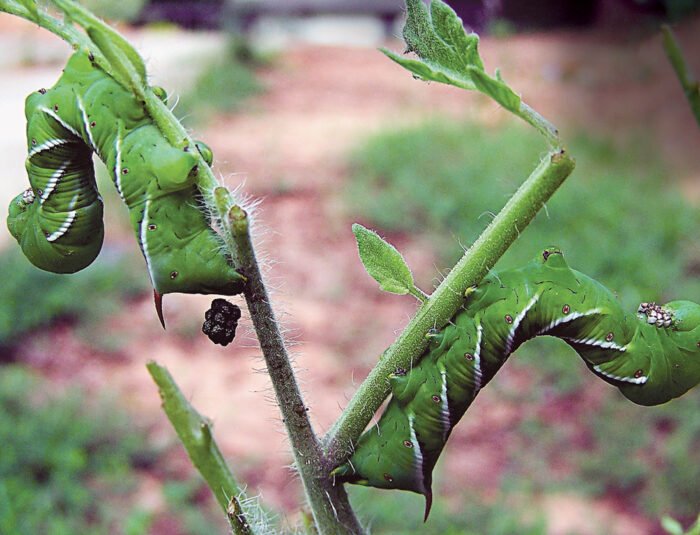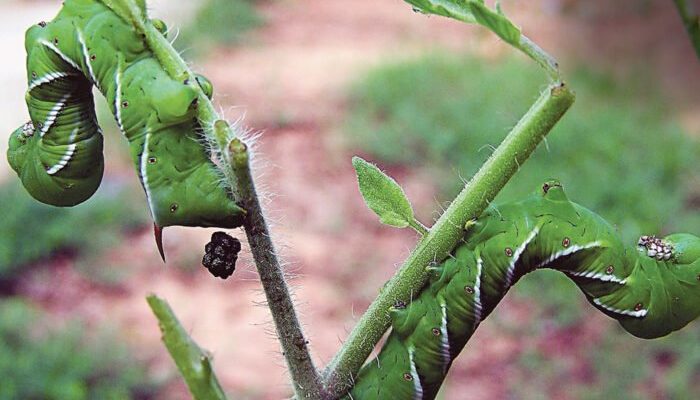
Let’s imagine your garden is a cozy café, where every plant is a delicious dish. Hornworms and caterpillars are like two types of customers; they both enjoy a meal, but they approach the menu in totally different ways. Understanding how they feast can help you protect your greens and keep your garden thriving. So, let’s dive in and explore how to tell the difference between hornworm damage and caterpillar damage.
What Are Hornworms?
Hornworms are pretty notorious among gardeners. These large, green caterpillars belong to the Sphingidae family and are the larval stage of moths, like the tomato hornworm (five-spotted hawk moth). You might spot them easily because they can grow up to 4 inches long! If you think about them as tiny green dragons, it’s easier to understand why they can cause such considerable damage in a short time.
Hornworms are well-known for their voracious appetite. They typically feed on tomato plants, peppers, and eggplants, but they can munch on other crops too. You’ll know you have hornworm damage when you see large, jagged holes in leaves or entire leaves disappearing overnight. Their droppings, which look like dark green pellets, are another telltale sign that these little beasts have paid a visit.
Understanding Caterpillars
Caterpillars are a broader category that includes many species, some of which can be detrimental to your garden. Unlike hornworms, which are often a single species, caterpillars can vary widely in size, color, and behavior. They might be green, brown, or even multicolored, making them a bit trickier to identify initially.
These guys can cause damage to a range of plants, not just tomatoes or peppers. Some catterpillars create small holes in leaves, while others tend to eat the edges, creating a ragged look. If you see webbing or silk on your plants, you might be dealing with caterpillars like leafrollers or webworms. Their droppings can also differ—often they look more like small, irregular bits rather than the uniform pellets of hornworms.
Hornworm Damage: Signs and Symptoms
When hornworms invade your garden, the signs can be alarming. They often strip the leaves off plants, making them look skeletal. In just a day or two, you might find your once-healthy tomato plant nearly defoliated. Here are some common signs of hornworm damage to watch for:
- Missing Leaves: Large sections of leaves may vanish overnight.
- Caterpillar Droppings: You’ll find dark green droppings scattered around the base of the plant.
- Visible Caterpillars: If you look closely, you might spot the hornworms themselves, often camouflaged against the plant.
The damage caused by hornworms can be especially devastating because they reproduce quickly. If not controlled, a few hornworms can turn into a full-blown infestation, causing even more destruction.
Caterpillar Damage: Signs and Symptoms
Caterpillars come with their own set of tricks when it comes to damage. Depending on the species, their feeding habits might differ, which can lead to a variety of symptoms across your plants. Here’s what to look for:
- Irregular Leaf Patterns: Leaves may have ragged, uneven edges or holes all over.
- Silk Webbing: This is a strong indicator of certain types of caterpillars, like webworms, which create webs as they feed.
- Droppings: Caterpillar droppings can vary in size and shape but are generally more irregular than hornworm pellets.
While caterpillar damage might not be as destructive as that from hornworms, certain species can still cause significant harm to hardy plants if they aren’t kept in check.
Comparing Hornworm and Caterpillar Damage
Understanding the differences in damage can be your secret weapon in managing your garden. Here’s a quick breakdown:
| **Aspect** | **Hornworms** | **Caterpillars** |
|—————————|——————————————-|——————————————-|
| **Appearance** | Large, green, smooth | Varies widely in color and size |
| **Damage Type** | Large holes, complete defoliation | Irregular holes, ragged edges |
| **Droppings** | Dark green pellets | Irregular shapes, various sizes |
| **Feeding Speed** | Very fast; can cause rapid damage | Depends on species; some slower |
Recognizing these differences can help you choose the right method to tackle the problem.
Preventing Damage from Hornworms and Caterpillars
You might be wondering how to keep these little munchers from wreaking havoc on your garden. Thankfully, there are several strategies you can employ to protect your precious plants:
- Regular Inspections: Check your plants for signs of hornworms or caterpillars regularly. The earlier you catch them, the easier it is to control.
- Natural Predators: Attract birds and other beneficial insects that prey on hornworms and caterpillars. Think of them as your garden’s bodyguards.
- Neem Oil: This natural pesticide can help deter caterpillars while being safe for your plants. Spray it on the affected plants, following the instructions carefully.
Preventive measures can save your garden from future infestations, keeping it flourishing and vibrant.
How to Treat Hornworm and Caterpillar Infestations
If you discover hornworms or caterpillars already snacking away, don’t panic! There are effective methods to manage these pests:
- Handpicking: For small infestations, simply pick the hornworms or caterpillars off your plants and relocate them to a more suitable environment.
- Pheromone Traps: These traps can lure adult moths, helping to reduce future generations of hornworms.
- Insecticides: When infestations are severe, consider using insecticides that are specifically designed for caterpillars. Always follow the application directions.
Prompt action is key to protecting your plants and ensuring they stay healthy.
Now that you know the differences between hornworm damage and caterpillar damage, you’re better equipped to handle any threats to your garden. Just remember, hornworms are like fast, ravenous diners, leaving behind only scraps, while caterpillars are varied eaters that can leave a mess behind. Keeping a vigilant eye on your plants and taking preventive measures can go a long way in maintaining a thriving garden. So grab your gardening gloves and take action before they turn your little café plants into a ghost town!

